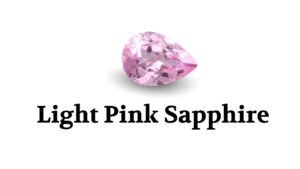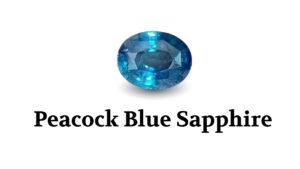Introduction
Light Blue Sapphire, with its serene hue and understated beauty, occupies a special place in the realm of gemstones, evoking feelings of tranquility and harmony.
Characteristics of Light Blue Sapphire
Physical Properties
Light Blue Sapphire is distinguished by its delicate blue color, ranging from pale azure to sky blue hues. With a hardness of 9 on the Mohs scale and a specific gravity averaging around 3.95, Light Blue Sapphire exhibits durability and resilience, making it suitable for various jewelry applications. Its refractive index contributes to its brilliance, creating a luminous sparkle that captures the eye.
Chemical Composition
At its core, Light Blue Sapphire shares the same chemical composition as other sapphires, primarily composed of aluminum oxide (Al2O3). However, the soft blue color of Light Blue Sapphire is often attributed to trace elements such as iron and titanium, which impart the gemstone with its characteristic hue.
Rarity and Value
Light Blue Sapphire’s rarity in nature elevates its value in the gemstone market, making it highly prized by collectors and enthusiasts. The scarcity of high-quality Light Blue Sapphire specimens, combined with their ethereal beauty and subtle elegance, contributes to their premium prices in the market.
Geological Formation
Light Blue Sapphire is formed through geological processes similar to other sapphires, with variations in mineral composition and environmental conditions leading to its distinctive blue color. These gemstones are typically found in gem-bearing gravels and alluvial deposits, where they have been transported by water and weathered over time.
Mining Locations
Light Blue Sapphire is primarily mined in regions known for sapphire deposits, including Sri Lanka, Madagascar, and Australia. These mining locations yield a variety of Light Blue Sapphire specimens, each with its own unique color and characteristics.
Uses and Applications
Jewelry
Light Blue Sapphire’s subtle beauty and tranquil hue make it a popular choice for fine jewelry. Whether set in platinum, gold, or silver, these gemstones add a touch of elegance and sophistication to any jewelry piece. Light Blue Sapphire rings, earrings, and pendants are coveted by those who appreciate the gemstone’s understated allure and timeless appeal.
Healing and Spiritual Practices
In addition to its ornamental value, Light Blue Sapphire is believed to possess healing and metaphysical properties in various cultures. From promoting mental clarity to enhancing spiritual awareness, Light Blue Sapphire is used in holistic practices to balance the throat chakra and foster communication and self-expression.
Identification and Authentication
Gemological Tests
Accurate identification of Light Blue Sapphire requires specialized gemological tests, including assessments of color, clarity, and optical properties. Gemologists utilize techniques such as spectroscopy and magnification to distinguish Light Blue Sapphire from other sapphires and gemstones, ensuring its authenticity and value.
Certification
Obtaining certification from reputable gemological laboratories is essential for validating the authenticity and quality of Light Blue Sapphire gemstones. These certifications provide assurance to buyers and collectors, confirming the gemstone’s provenance and characteristics.
Famous Light Blue Sapphire Gemstones
Notable Examples
While Light Blue Sapphire gemstones are relatively rare, there are several notable examples that have captured the attention of gem enthusiasts worldwide. From royal collections to museum exhibits, these gems showcase the beauty and allure of Light Blue Sapphire.
Historical Significance
Throughout history, Light Blue Sapphire gemstones have been cherished for their beauty and symbolism. From ancient civilizations to modern cultures, Light Blue Sapphire has been revered as a symbol of wisdom, truth, and inner peace. Whether worn as talismans or set in royal regalia, Light Blue Sapphire gemstones have left an indelible mark on human history and culture.
Myths and Legends
Folklore
Light Blue Sapphire gemstones have been surrounded by myth and legend throughout history, with tales of their mystical properties and magical powers. From ancient folklore to modern superstitions, Light Blue Sapphire gemstones have been believed to bring clarity of mind, protect against negative energies, and foster emotional healing.
Cultural Significance
Across cultures and civilizations, Light Blue Sapphire gemstones hold cultural significance, symbolizing everything from serenity and harmony to communication and self-expression. From the ancient Egyptians who associated sapphires with the sky goddess Nut to the Buddhists who revered them as symbols of purity and enlightenment, Light Blue Sapphire gemstones have played a central role in rituals, ceremonies, and celebrations.
Caring for Light Blue Sapphire Gemstones
Cleaning
Proper care and maintenance are essential to preserve the beauty and brilliance of Light Blue Sapphire gemstones. Gentle cleaning methods and precautions against harsh chemicals help safeguard their integrity and longevity, ensuring they remain radiant for generations to come.
Storage
Storing Light Blue Sapphire gemstones in a secure and controlled environment is crucial to prevent damage and preserve their value. Utilizing padded jewelry boxes or fabric pouches provides protection against scratches and abrasions, maintaining their exquisite appearance over time.
Conclusion
In conclusion, Light Blue Sapphire gemstones stand as a symbol of serenity, harmony, and inner peace, captivating hearts and minds with their delicate hue and timeless elegance. From their geological origins to their cultural significance, Light Blue Sapphire gemstones enrich our lives with their beauty and symbolism, serving as cherished treasures for generations to come. As we continue to admire and cherish these precious gems, their legacy and splendor will undoubtedly endure for centuries to come.



